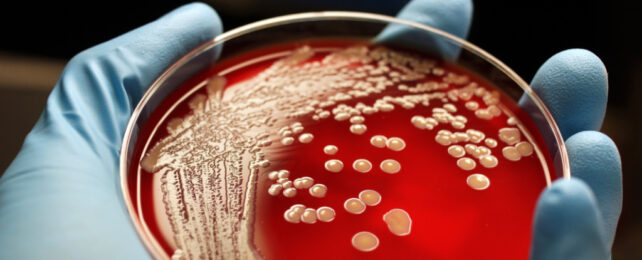Scientists have found an antibiotic-free way of treating 'golden staph' skin infections that are the scourge of some cancer patients, and a threat to hospital-goers everywhere.
The lab study from researchers at the University of Copenhagen utilized an artificial version of an enzyme that's naturally produced by bacteriophages (viruses that infect bacteria), and used it to eradicate Staphylococcus aureus, or golden staph, in biopsy samples from people with skin lymphoma.
"To people who are severely ill with skin lymphoma, staphylococci can be a huge, sometimes insoluble problem, as many are infected with a type of Staphylococcus aureus that is resistant to antibiotics," explains immunologist Niels Ødum of the University of Copenhagen.
"That is why we are careful not to give antibiotics to everyone, because we do not want to have to deal with more resistant bacteria. Therefore, it is important that we find new ways of treating – and not the least to prevent – these infections," explains Ødum.
S. aureus is a common inhabitant of our skin and nasal tract, and generally harmless. But it is an opportunistic pathogen: When immunity is lowered, it can cause all manner of infections, from minor skin infections such as boils and abscesses, right through to life-threatening illnesses such as pneumonia and sepsis.
In a hospital setting, drug-resistant strains of the bacteria are a grave and growing problem. S. aureus can find its way into the bloodstream during surgery or via medical devices such as catheters, slipping past the body's first line of defense: the skin and mucosal barriers (snot).
People with weakened immune systems who visit hospitals for regular treatments such as chemotherapy are also at risk of picking up nasty 'superbugs' that have become resistant to mainstay antibiotics.
In particular, people with skin lymphoma are highly susceptible to bacterial infections. Called cutaneous T-cell lymphoma, CTCL is a rare form of non-Hodgkin lymphoma that starts with cancerous T cells migrating to the skin. There, these rogue immune cells cause rashes and lesions before spreading to other parts of the body.
S. aureus expels substances called enterotoxins which are thought to fuel the progression of CTCL, because when patients with CTCL finish a round of antibiotics, S. aureus can quickly appear in skin lesions and their cancer symptoms can worsen.
Strains of S. aureus that are resistant to methicillin and other antibiotics are called MRSA, and while hospitals are making some ground in curbing MRSA infections, other drug-resistant superbugs are quick to take its place.
So, in this study, Ødum and his colleagues experimented with the new class of antibacterial agent called endolysins.
Endolysins are enzymes that are naturally produced by bacteriophages, viruses that infect bacteria. After infection, they slice up molecules called peptidoglycans that form mesh-like scaffolds in the bacteria cell wall, destroying the bacteria from the inside.
Each bacterial species has unique peptidoglycans, which the right endolysin could selectively target. One endolysin, XZ.700, was tested in this study, on skin samples collected from people with healthy skin, and those with CTCL.
"The great thing about this enzyme is that it has been designed to penetrate the wall of Staphylococcus aureus," explains lead author and University of Copenhagen immunology researcher Emil Pallesen.
"This enables it to target and kill the harmful staphylococcus and leave harmless skin bacteria unharmed."
In lab experiments, endolysin XZ.700 killed off strains of S. aureus that had been isolated from CTCL patients, and blocked its tumor-promoting effects on lab-grown malignant T cells.
Endolysin treatment also "profoundly" stopped S. aureus from colonizing samples of healthy skin and biopsies of lesioned skin from people with CTCL. It also sloughed off S. aureus colonies that had already settled on biopsied skin.
"Our lab tests have showed that endolysins do not just eradicate Staphylococcus aureus" from skin samples, says Ødum, but that they "also inhibit their ability to promote cancer growth."
While these lab-based experiments with skin biopsy samples in plastic dishes are a far cry from treating skin infections and cancer in real-world settings, the results are promising.
The researchers hope that endolysin XZ.700 could kill off drug-resistant strains such as MRSA and even biofilms, tightly wedded assemblages of microbes that are notoriously difficult to treat. Recent lab studies suggest this might be possible, all without S. aureus developing resistance to endolysins.
This last point is key, as bacteria are shifty microbes adept at finding new ways to evade and thwart antibiotic treatments faster than we can develop new drugs. More research is needed to really see if endolysins succumb to the same bacterial agility, or stand firm against staph infections.
In 2019, antibiotic resistance registered as the third leading cause of death worldwide. The urgent need to find new treatments to combat drug-resistant bacteria is not one only concerning skin lymphoma patients, but a pressing global issue.
The study has been published in the Journal of Investigative Dermatology.
